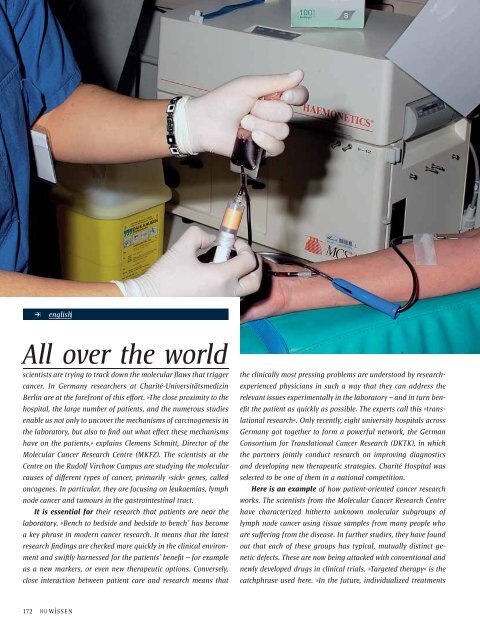hu wissen (pdf) - Exzellenzinitiative - Humboldt-Universität zu Berlin
hu wissen (pdf) - Exzellenzinitiative - Humboldt-Universität zu Berlin
hu wissen (pdf) - Exzellenzinitiative - Humboldt-Universität zu Berlin
Erfolgreiche ePaper selbst erstellen
Machen Sie aus Ihren PDF Publikationen ein blätterbares Flipbook mit unserer einzigartigen Google optimierten e-Paper Software.
All over the world<br />
scientists are trying to track down the molecular fl aws that trigger<br />
cancer. In Germany researchers at Charité-<strong>Universität</strong>smedizin<br />
<strong>Berlin</strong> are at the forefront of this eff ort. »The close proximity to the<br />
hospital, the large number of patients, and the numerous studies<br />
enable us not only to uncover the mechanisms of carcinogenesis in<br />
the laboratory, but also to fi nd out what eff ect these mechanisms<br />
have on the patients,« explains Clemens Schmitt, Director of the<br />
Molecular Cancer Research Centre (MKFZ). The scientists at the<br />
Centre on the Rudolf Virchow Campus are studying the molecular<br />
causes of diff erent types of cancer, primarily »sick« genes, called<br />
oncogenes. In particular, they are focusing on leukaemias, lymph<br />
node cancer and tumours in the gastrointestinal tract.<br />
It is essential for their research that patients are near the<br />
laboratory. »Bench to bedside and bedside to bench’ has become<br />
a key phrase in modern cancer research. It means that the latest<br />
research fi ndings are checked more quickly in the clinical environment<br />
and swi� ly harnessed for the patients’ benefi t – for example<br />
as a new markers, or even new therapeutic options. Conversely,<br />
close interaction between patient care and research means that<br />
172<br />
k english<br />
the clinically most pressing problems are understood by researchexperienced<br />
physicians in such a way that they can address the<br />
relevant issues experimentally in the laboratory – and in turn benefi<br />
t the patient as quickly as possible. The experts call this »translational<br />
research«. Only recently, eight university hospitals across<br />
Germany got together to form a powerful network, the German<br />
Consortium for Translational Cancer Research (DKTK), in which<br />
the partners jointly conduct research on improving diagnostics<br />
and developing new therapeutic strategies. Charité Hospital was<br />
selected to be one of them in a national competition.<br />
Here is an example of how patient-oriented cancer research<br />
works. The scientists from the Molecular Cancer Research Centre<br />
have characterized hitherto unknown molecular subgroups of<br />
lymph node cancer using tissue samples from many people who<br />
are suff ering from the disease. In further studies, they have found<br />
out that each of these groups has typical, mutually distinct genetic<br />
defects. These are now being attacked with conventional and<br />
newly developed drugs in clinical trials. »Targeted therapy« is the<br />
catchphrase used here. »In the future, individualized treatments



